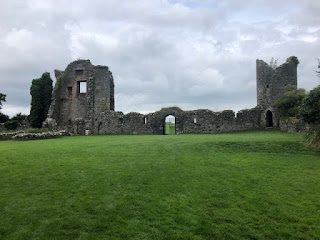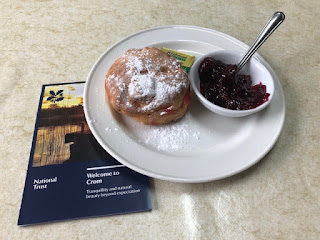I love the film Darby O'Gill and the Little People (released 60 years ago this very year, film fact fans!) but that's where my interest in little people ends. I left pixies and goblins and gnomes and fairies far behind in my Enid Blyton-powered childhood.
But if you said to me 'Sarah, there is one, and only one, National Trust property where elves can still be found - which one is it?' I would say "CROM!" without any hesitation (it's pronounced 'CRUM!' by the way, just in case you want to actually imagine me saying it without any hesitation).
I should probably clarify that I didn't actually see any 'wee folk' at Crom. It's just a very other-worldly kind of place, which was maybe helped by the fact that I visited late on a wet Sunday afternoon when everybody else was indoors, probably watching films about leprechauns.
Maybe a bit of history will help to explain its other-worldliness:
And then there's the all-important tea room. The one at Crom was quite unusual - it was much more informal than most National Trust cafeterias, which made me wonder if it was in fact a tenanted thing (and therefore not a mandatory inclusion on this National Trust Scone Quest).
But maybe an other-worldly place would serve other-worldly scones and I couldn't risk missing that, so I went in anyway. It turned out that the cherry scone I'd had earlier at The Argory was not a one off but part of a national scone trend across Northern Ireland. To be fair there was a choice (fruit or plain also on offer) but I decided to stick with the cherry. It was a nice scone - maybe a little bit dry, but it turns out that cherries are great at pepping up dry scones.
I also have to turn travel agent for a moment and tell you that Crom has the most beautiful holiday cottages (as well as glamping pods and a campsite), so if you're ever looking for somewhere to stay in County Fermanagh you should head there. Old castles, little people, buried treasure, scones - the perfect holiday right there.
Crom: 4.5 out of 5
Scone: 4 out of 5
Actual sightings of wee folk: 0 out of 5
But if you said to me 'Sarah, there is one, and only one, National Trust property where elves can still be found - which one is it?' I would say "CROM!" without any hesitation (it's pronounced 'CRUM!' by the way, just in case you want to actually imagine me saying it without any hesitation).
I should probably clarify that I didn't actually see any 'wee folk' at Crom. It's just a very other-worldly kind of place, which was maybe helped by the fact that I visited late on a wet Sunday afternoon when everybody else was indoors, probably watching films about leprechauns.
Maybe a bit of history will help to explain its other-worldliness:
- It's a very ancient and historic area - the shores of Lough Erne have been inhabited for over 6000 years, and prehistoric burial sites have been discovered there
- In the Middle Ages, the area was ruled by the Maguire kings who controlled Fermanagh
- The old castle (now a ruin - obviously) was built during the Plantation of Ulster. A man called Michael Balfour from Scotland was granted 1500 acres of land in 1610 that had belonged to the Maguires on the condition that he build a fortified residence on the River Erne.
- In 1655 it was acquired by the Creighton family and so the Crichtons arrived at Crom
- It was besieged twice in 1689 by soldiers of James II who were fighting to win back the British throne. They failed, and although Crom was damaged in the second siege the Crichton family retained their home.
- There's a legend that the family weren't confident of withstanding the siege and so buried their gold and jewellery under an oak tree, which is now known as the Treasure Tree. The treasure is still there apparently (although this seems very unlikely) and is guarded by 'wee folk' with the obligatory curse on anyone who digs it up.
- Everyone has a story about an attempt to dig up the treasure - my favourite was by a group of lads who took a black cat with them to try to offset the effects of the curse. However, the cat got really fed up after being taken out of its basket several times, each time the boys thought they were about to finally heave up the loot, and it ran off.
- The old castle was gutted by fire in 1764 and the Crichtons relocated to Dublin. A new castle was finished in 1838 but that also burnt down in 1841 and had to be rebuilt again.
- The new castle still stands and is a wedding venue and hotel today.
- There's a story about a local priest who married a Protestant woman to a Catholic man in 1852 and had to flee the country to America to avoid going to prison, as this was illegal. The Crichtons were big sailing fans and for one race in 1857 the Earl of Erne offered the crew anything they wanted if they won. They did win and the crew asked for the priest to be returned to the parish and not prosecuted. The Earl pulled a few strings and he was able to come home.
- An author called Shan Bullock grew up on the estate and wrote many books based on his childhood.
There are other sites to see beyond the old castle:
- Crichton Tower was built as a folly out on Gad Island in 1847 during the Great Famine (it's known simply as 'Gad' to locals). As well as being ornamental, it acted as an observation platform for the many sailing races that went on during the summer months and for star-gazing.
 |
| Crichton Tower - used for watching the stars and the sailing |
- Two ancient yew trees can be found near the old castle. The legend goes that an O'Neill who had been involved in a rebellion against Elizabeth I said farewell to the love of his life under the trees, which means they would have been full grown 400 years ago, making them over 1000 years old today. I found them quite spooky - the way their branches reach out and entwine was almost spider-like.
 |
| The two very (very) old yew trees at Crom |
But maybe an other-worldly place would serve other-worldly scones and I couldn't risk missing that, so I went in anyway. It turned out that the cherry scone I'd had earlier at The Argory was not a one off but part of a national scone trend across Northern Ireland. To be fair there was a choice (fruit or plain also on offer) but I decided to stick with the cherry. It was a nice scone - maybe a little bit dry, but it turns out that cherries are great at pepping up dry scones.
I also have to turn travel agent for a moment and tell you that Crom has the most beautiful holiday cottages (as well as glamping pods and a campsite), so if you're ever looking for somewhere to stay in County Fermanagh you should head there. Old castles, little people, buried treasure, scones - the perfect holiday right there.
Crom: 4.5 out of 5
Scone: 4 out of 5
Actual sightings of wee folk: 0 out of 5



No comments:
Post a Comment